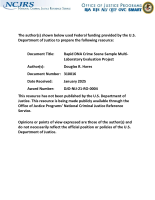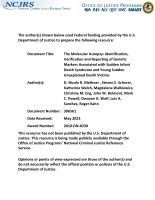DNA testing
Develop and Implement DNA Technology in the Regional Forensic Science Center
Genetic Privacy and the Case of the Golden State Killer—Diving into the Science
Rapid DNA Crime Scene Sample Multi-Laboratory Evaluation Project
Physical and Biochemical Factors Affecting the Recovery and Analysis of DNA from Human Skeletal Remains
A DNA Barcoding Strategy for Blow and Flesh Flies Encountered during Medicolegal Casework
Advancing Justice for the Missing and Unidentified Through Research - 2024 NIJ Research Conference
Forensic science research is developing essential knowledge to fill in the holes in death investigations, creating new ways to identify challenging skeletal remains. These methods inform cause of death, time of death, and familial relationships to guide investigations, identify suspects, support prosecutions, and bring justice to families.
See the YouTube Terms of Service and Google Privacy Policy





